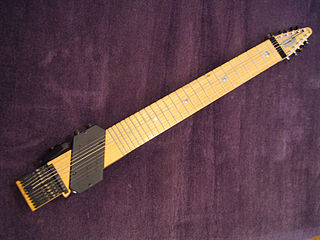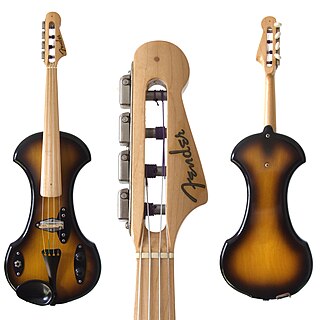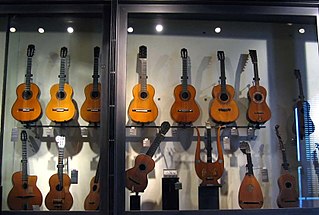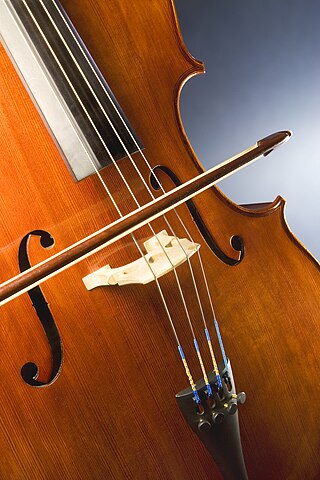
The Springtime is an experimental electric guitar with seven strings and three outputs. The instrument was created in 2008 by Dutch luthier Yuri Landman for guitar player Laura-Mary Carter of Blood Red Shoes. [1]

The Springtime is an experimental electric guitar with seven strings and three outputs. The instrument was created in 2008 by Dutch luthier Yuri Landman for guitar player Laura-Mary Carter of Blood Red Shoes. [1]
The string set up of the guitar is 1 bass string, 3 wound guitar strings for the chords and a cluster of 3 unwound strings tuned off-key unison, causing a rapid vibrating tone. Each group of strings has its own individual output for three amplifiers to preserve tonal interference. The sound simulates three musicians at once; a bass player, a rhythm guitarist and a solo guitarist or a Greek electric bouzouki. The instrument also is fitted with a so-called tailed bridge (as on a Fender Jaguar) to increase overtone possibilities. The electronics contain switches to change the 3-way system to stereo or mono if fewer amplifiers are available.
Landman handed over his prototype to Carter before their sold out gig on May 19, 2008 in the venue Doornroosje in Nijmegen, Holland. [2]
This is the first guitar created by Landman which is put in serial production. The reproductions have a red or blank body. [3]
A few months after the first Springtime, Landman built the Springtime II on specifications made up by Lou Barlow. [4] Barlow's version has eight tuning pegs, two of them unused, but available for an alternative seven or eight string set up. The other six employ the strings for the instruments in four positions similar to a bass guitar, but the upper two positions are double coursed strings. Because of this the instrument remains a six string guitar. Also the pickup configuration is different and four single coils are present instead of three. The lowest positioned pickup is left out and a regular bridge and neck pickup are placed aside of the rotated pickup duo. The velcro tape to mute undesired string resonance from the tailed bridge is also not present on this version.

Also other alternate versions of the Springtime exist. For Mauro Pawlowski of dEUS Landman made an alternate version with nine tuning pegs and an additional pick up in the tail to explore the possibilities of creating third bridge sounds. This pick up has a separate output. Also a fifth pick up was added, similar to the bridge pick up present at Barlow's version. Also a red version for Meric Long of The Dodos is made with an alternate pickup and string configuration.
A red Springtime was used by Placebo frontman Brian Molko in 2008, while he was in the studio for recording Battle for the Sun . On the Battle for the Sun bonus DVD, Molko is seen experimenting with the Springtime and discussing its possible uses with producer David Bottrill.

The bass guitar, electric bass or simply bass is the lowest-pitched member of the guitar family. It is a plucked string instrument similar in appearance and construction to an electric or acoustic guitar, but with a longer neck and scale length, and typically four to six strings or courses. Since the mid-1950s, the bass guitar has largely replaced the double bass in popular music.

An electric guitar is a guitar that requires external amplification in order to be heard at typical performance volumes, unlike a standard acoustic guitar. It uses one or more pickups to convert the vibration of its strings into electrical signals, which ultimately are reproduced as sound by loudspeakers. The sound is sometimes shaped or electronically altered to achieve different timbres or tonal qualities from that of an acoustic guitar via amplifier settings or knobs on the guitar. Often, this is done through the use of effects such as reverb, distortion and "overdrive"; the latter is considered to be a key element of electric blues guitar music and jazz, rock and heavy- metal guitar playing. Designs also exist combining attributes of the electric and acoustic guitars: the semi-acoustic and acoustic-electric guitars.

The guitar is a fretted musical instrument that typically has six strings. It is usually held flat against the player's body and played by strumming or plucking the strings with the dominant hand, while simultaneously pressing selected strings against frets with the fingers of the opposite hand. A plectrum or individual finger picks may also be used to strike the strings. The sound of the guitar is projected either acoustically, by means of a resonant chamber on the instrument, or amplified by an electronic pickup and an amplifier.

String instruments, stringed instruments, or chordophones are musical instruments that produce sound from vibrating strings when a performer plays or sounds the strings in some manner.

The hurdy-gurdy is a string instrument that produces sound by a hand-crank-turned, rosined wheel rubbing against the strings. The wheel functions much like a violin bow, and single notes played on the instrument sound similar to those of a violin. Melodies are played on a keyboard that presses tangents—small wedges, typically made of wood or metal—against one or more of the strings to change their pitch. Like most other acoustic stringed instruments, it has a sound board and hollow cavity to make the vibration of the strings audible.

The Chapman Stick is an electric musical instrument devised by Emmett Chapman in the early 1970s. A member of the guitar family, the Chapman Stick usually has ten or twelve individually tuned strings and is used to play bass lines, melody lines, chords, or textures. Designed as a fully polyphonic chordal instrument, it can also cover several of these musical parts simultaneously.

The acoustic bass guitar is a bass instrument with a hollow wooden body similar to, though usually larger than, a steel-string acoustic guitar. Like the traditional electric bass guitar and the double bass, the acoustic bass guitar commonly has four strings, which are normally tuned E-A-D-G, an octave below the lowest four strings of the 6-string guitar.

An electric violin is a violin equipped with an electronic output of its sound. The term most properly refers to an instrument intentionally made to be electrified with built-in pickups, usually with a solid body. It can also refer to a violin fitted with an electric pickup of some type, although "amplified violin" or "electro-acoustic violin" are more accurate then.

An eight-string guitar is a guitar with eight strings, or one more than the Russian guitar's seven. Eight-string guitars are less common than six- and seven-string guitars, but they are used by a few classical, jazz, and metal guitarists. The eight-string guitar allows a wider tonal range, or non-standard tunings, or both.
The Fender Jaguar is an electric guitar by Fender Musical Instruments characterized by an offset-waist body, a relatively unusual switching system with two separate circuits for lead and rhythm, and a short-scale 24" neck. Owing some roots to the Jazzmaster, it was introduced in 1962 as Fender's feature-laden top-of-the-line model, designed to lure players from Gibson. During its initial 13-year production run, the Jaguar did not sell as well as the less expensive Stratocaster and Telecaster, and achieved its most noticeable popularity in the surf music scene. After the Jaguar was taken out of production in 1975, vintage Jaguars became popular first with American punk rock players, and then more so during the alternative rock, shoegazing and indie rock movements of the 1980s and 1990s. Fender began making a version in Japan in the mid-1980s, and then introduced a USA-made reissue in 1999. Since then, Fender has made a variety of Jaguars in America, Mexico, Indonesia and China under both the Fender and Squier labels. Original vintage Jaguars sell for many times their original price.

A pickup is a transducer that captures or senses mechanical vibrations produced by musical instruments, particularly stringed instruments such as the electric guitar, and converts these to an electrical signal that is amplified using an instrument amplifier to produce musical sounds through a loudspeaker in a speaker enclosure. The signal from a pickup can also be recorded directly.

The electric upright bass (EUB) is an instrument that can perform the musical function of a double bass. It requires only a minimal or 'skeleton' body to produce sound because it uses a pickup and electronic amplifier and loudspeaker. Therefore, a large resonating structure is not required to project the sound into the air. This minimal body greatly reduces the bulk and weight of the instrument. EUBs must always be connected to an amplifier and speaker cabinet to produce an adequate audible sound. The EUB retains enough of the features of the double bass so that double bass players are able to perform on it.

The following outline is provided as an overview of and topical guide to guitars:

A guitar technician is a member of a music ensemble's road crew who maintains and sets up the musical equipment for one or more guitarists. Depending on the type and size of band, the guitar tech may be responsible for stringing, tuning, and adjusting electric guitars and acoustic guitars, and maintaining and setting up guitar amplifiers and other related electronic equipment such as effect pedals.

An experimental musical instrument is a musical instrument that modifies or extends an existing instrument or class of instruments, or defines or creates a new class of instrument. Some are created through simple modifications, such as cracked cymbals or metal objects inserted between piano strings in a prepared piano. Some experimental instruments are created from household items like a homemade mute for brass instruments such as bathtub plugs. Other experimental instruments are created from electronic spare parts, or by mixing acoustic instruments with electric components.

Yuri Landman is a Dutch inventor of musical instruments and musician who has made several experimental electric string instruments for a number of artists including Lee Ranaldo of Sonic Youth, Liars, Jad Fair of Half Japanese, Liam Finn, and Laura-Mary Carter. Besides his musical activities he is also a graphic novel artist.

The Moodswinger is a twelve-string electric zither with an additional third bridge designed by Yuri Landman. The rod which functions as the third bridge divides the strings into two sections to cause an overtone multiphonic sound. One of the copies of the instrument is part of the collection of the Musical Instrument Museum in Phoenix, Arizona.

Bradford Reed is an American multi-instrumentalist, experimental luthier, and member of the avant-garde band King Missile III. In the 1980s he invented the pencilina, a custom made string instrument.

A bridge is a device that supports the strings on a stringed musical instrument and transmits the vibration of those strings to another structural component of the instrument—typically a soundboard, such as the top of a guitar or violin—which transfers the sound to the surrounding air. Depending on the instrument, the bridge may be made of carved wood, metal or other materials. The bridge supports the strings and holds them over the body of the instrument under tension.

Experimental luthiers are luthiers who take part in alternative stringed instrument manufacturing or create original string instruments altogether.